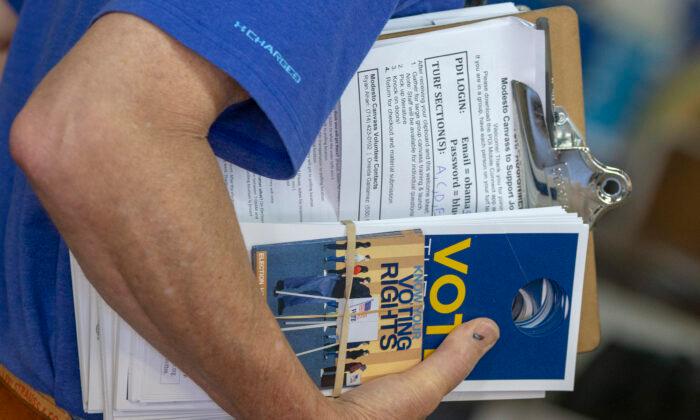With the Nov. 8 election already two weeks ago, we are conditioned to accept that some final results won’t be known until Dec. 16, five weeks later. Counting proceeds at a crawl in counties up and down the state, and those among us with housebroken political sentiments are expected to be impressed at the diligent performance of our election professionals.
In truth, however, no major nation on earth takes this long to count ballots, and no state in America takes as long as California to complete its tallies. As of Nov. 15, there were still at least a dozen races for a seat in the U.S. Congress that remained undecided. Seven of them, more than half, are here in California.
What has happened to the election process in California is a travesty. For more than 30 years, political power has steadily drifted toward what is now a one-party state. Democrats control all the higher state offices, from governor to state superintendent of public instruction, and none of that will change. In the state Legislature, Democrats control what is referred to as a mega-majority in both the Assembly and the Senate. Unlike a super-majority, in which two-thirds of the seats in a chamber are occupied by members of a single party, a mega-majority means that three-quarters of the seats are controlled by one party. That, too, won’t change once the final results are announced.
The reason for this dominance by one party can be misleading, however, because it isn’t a party so much as a political machine, controlled by government unions, that exercises power in Sacramento.
Years of closed-shop government employee union dues have gone to supporting campaigns to elect politicians obedient to these unions. After the U.S. Supreme Court, in a 2016 ruling, relieved government employees of mandatory payment of union dues (or “agency fees”), union membership remains almost universal, enforced by intimidating in-house peer pressure by union operatives. Union dues now average more than $1,000 per government employee, and with over a million state and local government employees in California, these unions have more than a billion dollars per year to work with. As the government workforce grows, so grows the financial underpinning of even more union domination.
In particular, the growth of the Service Employees International Union (SEIU) along with the teachers unions has created the two primary sources of the political destruction of California, funded by our own tax dollars to work against us. We voted for “education,” and empowered the teachers union to destroy curricula in favor of indoctrinating a generation of young Californians to resent their nation, reject hard work, mistrust one another based on the color of their skin, and acquire narcissistic self-esteem instead of marketable skills. We voted for humane social services, and instead, we got insatiable, inefficient SEIU hiring.
These unions move in unison—threaten one and the entire machine moves against anyone who dares to take them on.
Giving California away to government unions was phase one in the destruction of California’s democracy. Phase two was already underway as we entered a new decade in 2020, but the COVID pandemic enabled its full implementation in a matter of months. Winning elections that might otherwise be competitive has devolved into a formulaic contest in which only one political machine has the money and manpower to participate: the government unions. The “reforms” they enacted rest on four fundamental changes: universal mailed ballots, early voting, same-day voter registration, and ballot harvesting.
If early voting trends show the union-backed Democrat is facing an opponent whose voters are turning out in stronger than anticipated numbers, they immediately invest more money in ballot harvesting during the weeks before election day. The ballot harvesters, using apps on their cell phones that are tied into proprietary databases, know which household residents have registered with which party. Early voting lets them know how many votes they will need, and ballot harvesting lets them control how many votes they will get. It’s all legal.
In cases where an election remains close in the final days prior to the election, same-day registration is the next weapon deployed by the machine. Even though in the just-completed election the last day to register to vote as a traditional voter was Oct. 24, paid and volunteer operatives could assist people with same-day registration as a “conditional voter” right up until and through election day, Nov. 8. They know exactly who to register. For example, the teachers union has ensured that the vast majority of young voters are thoroughly conditioned to vote for Democrats and to despise Republicans. The machine has a profile for every eligible voter in the state. It knows where every person under age 30 lives, and if they’re not registered, it sends operatives to get them a same-day registration and a provisional ballot, which they can then harvest. And it’s all legal.
Such is the reality of elections in California today. If anyone questions the ethics of ballot harvesting, or the accuracy of the registered voter database from which ballots are mailed to everyone, or the injustice of taxpayer-funded government unions recruiting candidates, paying for their campaigns, and using their massive political machine to scientifically ensure their victory, they are stigmatized as an “election denier.”
Expect to be very surprised if any of the close races in California, from the U.S. Congress to the local school board, end up going to a Republican. The system is a joke. To have a fair election, Californians must return to time-tested methods. If you want to vote, you have to register six weeks or more before the election. Then on Election Day, you go to a polling center, present an ID, and receive a paper ballot. You mark the ballot manually to ensure the markings actually reflect what you were voting for or against. Then all these ballots are tabulated at the precinct and county level, reported at the end of the night, and saved for future audit. That’s a corruption-proof voting process.
Instead, we wait for weeks to get results that used to be ready in hours. All the while, we hope against all odds that the ideas our favored candidates fought for attracted enough voters to beat the machine.





